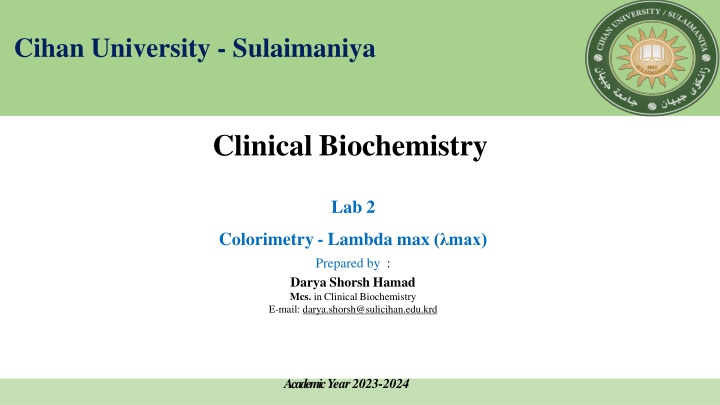
Colorimetric Analysis in Clinical Biochemistry Lab
Colorimetric analysis is a method used in clinical biochemistry labs to quantify compounds in serum based on color reactions. This technique involves preparing reagent blanks, standard solutions, and test solutions to measure sample concentrations. Calculation methods include using standard concentrations or calibration curves. Understanding Lambda max (max) is crucial for determining the maximum absorbance wavelength of a substance, providing insights into the compound's electronic structure and maximizing sensitivity.
Download Presentation

Please find below an Image/Link to download the presentation.
The content on the website is provided AS IS for your information and personal use only. It may not be sold, licensed, or shared on other websites without obtaining consent from the author. If you encounter any issues during the download, it is possible that the publisher has removed the file from their server.
You are allowed to download the files provided on this website for personal or commercial use, subject to the condition that they are used lawfully. All files are the property of their respective owners.
The content on the website is provided AS IS for your information and personal use only. It may not be sold, licensed, or shared on other websites without obtaining consent from the author.
E N D
Presentation Transcript
Cihan University - Sulaimaniya Clinical Biochemistry Lab 2 Colorimetry- Lambda max ( max) Prepared by : Darya Shorsh Hamad Mcs. in ClinicalBiochemistry E-mail: darya.shorsh@sulicihan.edu.krd AcademicYear2023-2024
Colorimetric Determination Principle Colorimetric analysis is a method to analyze a color. In this case a specific reagent is used to react with a specific component in the serum and a colored complex is formed which is directly proportional to the concentrationof the compound in the serum. Example: The blood urea colorimetric procedure is a modification of the Berthelot reaction. Urea is hydrolyzed in the presence of water and urease to produce ammonia and carbon dioxide. Ammonium ions react with hypochlorite and salicylate to give a green dye. The intensity of the color formed at 578 nm is proportionalto the urea concentrationin the sample.
Requirements of ColorimetricAnalysis In colorimetric assays three tubes should be prepared as follow: 1.Reagent blank: which contain the reagents only (without any Test OD=? C=? Standard OD=? C=100mg/dl blank test or standard substance) and used to set instrument at zero absorbance (Any color given by the reagents used in the analysis can be detected and eliminated) 2.Standard solution: it is a substance identical to the test solution with a known concentration (it is different from an assay to another according to the measured parameter) 3.Test solution: This contains the unknown concentration of the substance together with the reagents used in the test.
Calculations Calculation of sample concentration can be done by two methods: 1. Using standard concentration: 2. Using calibration curve Slandered calibration curve are obtained by measuring the absorbance of a series of standard solutions. After a series of standard solutions are analyzed a graph of absorbance versus concentration is drawn and it will be a linear relationship. Solutions of unknown concentration are tested for absorbance; these absorbance results are read from the curve to determine concentration.
LAMBDA( ) MAX The wavelengthwhich a substance shows maximumabsorbanceis called maximum absorptionor max. The value of max is importantforseveral reasons: This wavelengthis characteristicof each compound It providesinformationon the electronic structureof the analyte It ensureshighestsensitivityand minimize deviationsfrom Beer's Law.
Principle of max measurement The principle behind the determination of Lambda max of any colored substance is that the colored substance absorbs maximum radiation at a particular wavelength in the visible region (400-800 nm). This colored substances absorb the radiation in different manner depending upon the wavelengths used. This unique property of maximum absorption at a particular wavelength is known as max and is useful for identification of that particular substance. max is not usually affected by concentration used.
Procedure: 1. Weightaccurately 100 mg of KMNO4 and dissolvein 30 ml of distilledwater in a volumetric flask. 2. Make up the volume up to 100ml with distilled water. 3. Now take 4 ml of above solution and dilute to 20 ml with distilledwater in order to get resulting solution(40 g/ml) 4. Switch on the colorimeter and allow to stabilize for 15 minutes. 5. Set the absorbanceat zero by using distilledwater as blank. 6. Now set 100%transmittanceby distilled water. 7. Take the absorbanceof the resultingsolution at differentwavelengths 8. Plot the graph between wavelengthvs observed absorbance.
Calculation of LAMBDA( ) MAX Wecan determine max by plotting absorbance vs wavelengthin graph. Wavelength( ) Absorbance (OD) 460 ? 480 ? 500 ? 520 ? 540 ? 560 ? 580 ? 600 ? 620 ?
